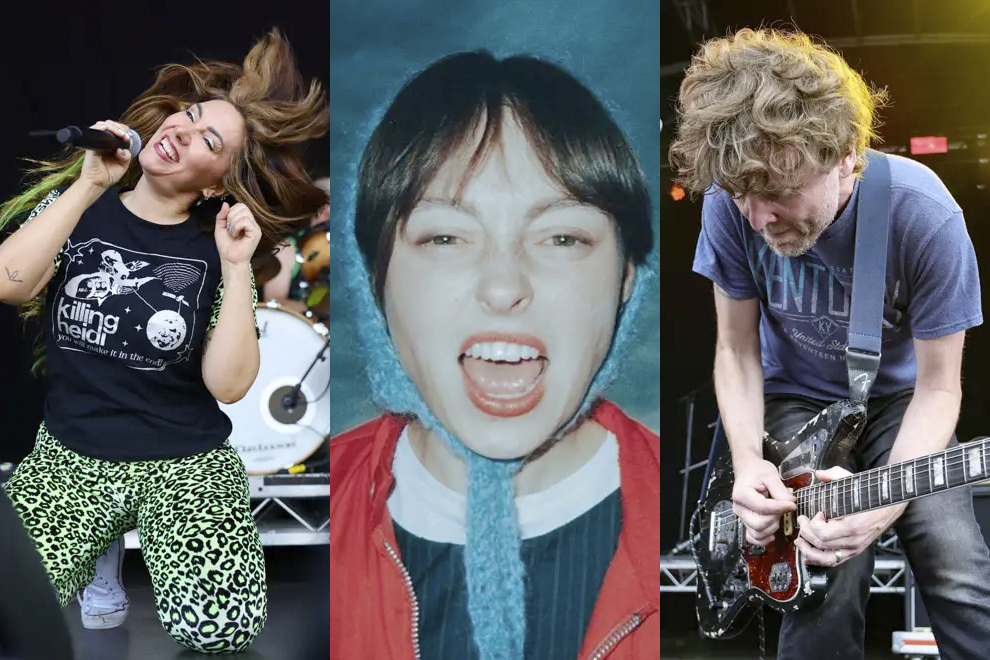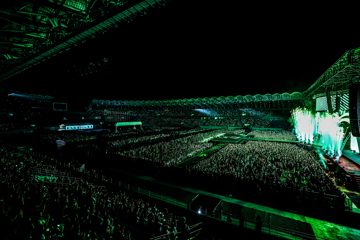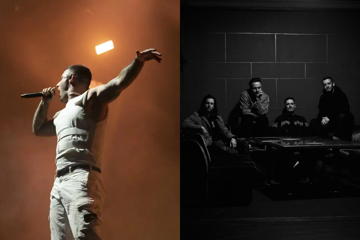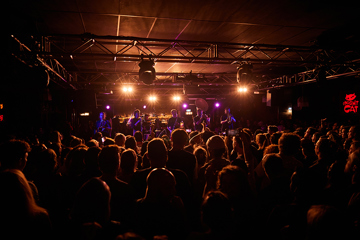Sharehouses, Social Issues & Supporting Rising Stars: Does Australian Indie Rock Have Its Own Sound?
Breaking down the sonic threads that are hallmarks of what constitutes the Australian indie rock genre.

Killing Heidi, Stella Donnelly & Jebediah (Credit: Peter Dovgan; Nick McKinlay; Peter Dovgan)

I think it is safe to say that Australians have a fraught relationship with their own art. Historically, inbuilt into our production and consumption of art here in the so-called “lucky country” is a deep-rooted sense of inferiority.
Whether it comes to literature, film, or music, cultural cringe abounds.
A.A. Phillips first coined the term “cultural cringe” in 1950 in an essay for Meanjin, describing the complex as “a disease of the Australian mind” defined by the overwhelming fear that “the domestic cultural product will be worse than the imported article.”
Australian artists, he writes, feel the need to compare their art to the art that is gestated by British culture, historically thought of as rooted in deeply storied traditions, and, therefore, superior.
(It of course must be noted that this sense of inferiority thus stems from a deeply colonial mindset – one that assumes that culture in Australia saw its genesis with the arrival of colonial settlers in 1788. First Nations people have been creating and telling stories on this soil for tens of thousands of years.)
Phillips was mainly discussing Australian literature, but one could decode what he was saying about the uncertainty of our national identity any apply it to how we produce and consume Australian music too – specifically to Australia indie rock.
Don't miss a beat with our FREE daily newsletter
Australian indie rock does unequivocally have its own sound, and that pesky sense of inferiority may be a large part of the reason why.
Indie music, by nature of being created outside of major labels demands, showcases the true essence of current cultural feeling. And a nation shaped by isolation and doubt will naturally give way to indie music with a twisted, disaffected atmosphere.
Indie is a broad category; the term is loose, and gets tossed around frequently, attached to a wide, variegated assembly of Australian bands. It begs the question, what does Australian indie music actually sound like?
I would argue that the best of Aussie indie music bears a common thread: the songs will exist in a hazy sonic space, its sound enjoyable and accessible, but will be shot through with deeply cutting lyrical content.
One of the prime early examples of a song that showcases these characteristics is The Go-Betweens’ 1988 sleeper hit Streets Of Your Town. It’s got this dreamy, nostalgic quality, buoyed by Spanish-inflected guitar that is at once bittersweet and cheerful, and backing vocals that are light and airy.
Speaking to The Guardian in 2018, violinist and backing vocalist Amanda Brown calls “it a “widely misunderstood song…It’s actually very dark.” It has, historically, been mistaken as painting a pretty, parochial picture of Brisbane. But the song has this pointed duality to it. Or, as Grant McLennan eerily sings, “And don’t the sun look good today?/But the rain is on its way.”
The song goes on to summon up chilling images of butcher’s knives and “battered wives.” Even the lyrics of the chorus – “round and round, up and down” – evoke the cyclical feelings of restlessness and boredom. “I still don’t know what I’m here for,” McLennan pines.
What The Go-Betweens did pioneered that characteristic Australian coziness of sound, though some, of course, do it better than others. The reason it works for The Go-Betweens is because they undercut that sound with a corruscating narrative edge.
In the 1990s, indie labels in Australia saw a major boom. According to Junkee, the ‘90s were, in fact, when the term “indie rock” properly took hold in Australia, gradually overtaking “college rock” and “alternative” as the go-to umbrella terms.
This was accompanied and bolstered by the expansion of Australia’s live music sector through the ‘90s and 2000s. There was a strong increase in the number of contemporary festivals being staged, and the amount of local artists being platformed: Byron Bay’s Bluesfest debuted in 1990, Big Day Out debuted in 1992, Fairbridge Festival debuted in 1993, Laneway debuted in 2005. These booms, necessarily, go hand in hand.
(It is worth noting, as musician and academic Matthew Bannister wrote in Loaded: Indie Guitar Rock, Canonism, White Masculinities, who wrote that indie music is often falsely treated “as if it really was independent. It is often represented as a relatively autonomous space, the product of isolated, marginal, local scenes, uncaptured by ideology, free of the commercial and other pressures that mark the mainstream, but also free of high culture elitism.” This is, of course, untrue, given that indie music naturally must balance “financial viability with street credibility.”)
During this stretch of time, local indie bands, because of this rising emphasis on live performance – which functions as a massive contribution to the Australian economy – were becoming more viable, and were therefore swelling in quantity, partially ushered in by Australian entrepreneur Stephen Pavlovic’s booking prowesses (who started booking live music venues with bands like The Celibate Rifles, Ratcat, The Hummingbirds, The Cruel Sea, and Kiwi acts The Clean and Straitjacket Fits, and also went on to work with the likes of Nirvana and My Bloody Valentine).
1994 saw the formation of Jebediah, and 1996 saw them catapult to national acclaim with the single Jerks Of Attention. The song has grungy guitar and strained, disaffected vocals, evoking a weed-induced lethargy – the kind of sound that indicates that Nirvana had catapulted into the stratosphere a few years before.
The melody is dirty and the sonics are amateurish in a cultivated way – the music video is, indeed, filmed in a sharehouse – indicating a scrappy, DIY approach that was to extensively saturate the indie rock scene for years to come.
Killing Heidi burst onto the scene with the song Mascara, the second single from their debut album Reflector. The guitar-fronted song is the musical embodiment of frustration boiling over, and needing to be unleashed into microphone-gripping and fret-thrashing. Killing Heidi was deliciously angsty, flamboyantly unimpressed.
Lead singer Ella Hooper exhibited a defiant personality – complete with piercings, layered necklaces, and streaks of colour through her dreaded mane of hair – that was arguably a precursor to later Aussie indie rock heavyweights such as Courtney Barnett and Stella Donnelly.
Mascara went on to become a number one hit, and Reflector became the fastest-selling Australian album in history at the time. Killing Heidi went on to become, according to Billboard’s Christine Eliezer, one of three “major domestic breakouts" in 1999 in Australia, “all released on independent labels.” The others were Vanessa Amorosi and Sister2Sister.
Around the same time, Something For Kate became known for their abrasive sound. Monsters, the 2001 track that solidified their Oz rock status, however, is universal, anthemic.
Its sound is once again gritty, but with a classically catchy chorus which sounds tailor-made to be sung along to after one schooner too many: “Wipe me out. Wipe me out…Shut me out. Shut me out.” (Musical repetition is perfect in a pub setting.) Monsters clocked in at second place for triple j’s Hottest 100 that year.
In the years to follow, Australia’s most successful musical exports were Gotye, Vance Joy, Sia – none of whom could be sanely described as “indie rock,” but were staunch pop heavyweights.
Australia’s indie rock sector was, perhaps, experiencing a lull – as digital streaming platforms were overtaking the culture and irrevocably changing the landscape of the music industry – until things began to pick up again in the mid-2010s.
2015 saw the rise of the indomitable Courtney Barnett, with the release of her debut album Sometimes I Sit And Think, And Sometimes I Just Sit. Barnett ushered in the modern generation of coruscatingly lyric-driven Australian indie singer-songwriters.
Her song Depreston comes to mind. Barnett’s heavily accented vocals are flat but inviting, the guitarwork is poignant. Similar to Streets Of Your Town, Barnett depicts a scene of suburban mundanity. Descriptions of a bungalow in the Victorian suburb of Preston become meditations on home ownership, which become meditations on mortality.
In 2019, Stella Donnelly was touted as the rising star of Aussie indie rock on the basis of her debut album Beware Of The Dogs (and I believe she has been crucial in carrying over The Go-Betweens’ shining torch).
Her musical personality is largely defined by often cheeky, playful – but occasionally solemn – deliberations on social issues. Donnelly also pointedly centres the guitar across Beware Of The Dogs – something that is a pre-requisite for Australian indie.
Old Man, the first single released to promote Beware Of The Dogs, is a sonically jubilant evisceration of a male predator. The guitar riff is jaunty, breezy; her vocal delivery is wide-eyed and cheerful as she sings, “Your personality traits/Don’t count if you put your dick in someone’s face.”
This haunting use of juxtaposition is a defining trait of Beware Of The Dogs, and is something that can also be attributed to the best of Donnelly’s peers.
Think of indie darling Julia Jacklin. Listening to her music is like sinking into a bath. Her angelic soprano soothes. On Head Alone, Jacklin delicately croons the lyrics, “I don’t want to be touched all the time/I raised my body up to be mine.”
The reverb-soaked guitar cushions her words, which seem to be depicting a smothering kind of physical intimacy – and, though it is admittedly ambiguous, could even be hinting at assault. With her full-throated leap into the final chorus, she doubles down on themes of bodily reclamation: “So say it, till he understands/You can love somebody without using your hands.”
Angie McMahon exhibited a similar approach in 2019 on her debut album Salt. McMahon’s music is what I personally refer to as “sharehouse-core” – her songs have that scrappy, DIY quality we saw with Jebediah, portraying the vibe of having been recorded through a dinky set-up in someone’s bedroom, even if they haven’t been – mirroring the housing crisis and the myriad economic crises young Australians especially are facing.
A song like Pasta offers up the very modern feelings of lethargy and isolation for dissection, an anthem for a generation beset by lockdowns and phone addictions. Or, as McMahon says, as the snarling guitar dies down, “There’s plenty of ways to be alone/I guess I spent all of yesterday on my phone.”
I would also classify Ruby Fields as “sharehouse-core.” Her guitarwork is grungy, systematically untidy. A song like P Plates, with its title alone, evokes the disaffection of youth. Fields, in the vein of Barnett and Donnelly, also pointedly maintains her Aussie twang while singing.
Up-and-coming indie-rocker Suzi is also expanding this tentatively growing pool of proudly-accented Australian singers.
But where does Australian indie rock sit at this very moment?
Speaking to The Guardian earlier this year, Ella Hooper expressed thoughts that the nature of local success had changed drastically since Killing Heidi first broke into the industry, due to the way that social media and streaming platforms have homogenised music consumption globally.
“I don’t know if anyone [in Australia] can be successful in quite the same way as we were – I don’t often see those white-hot moments where it’s just everywhere,” she explained. “I can’t think of any that have gone through that since [the likes of] Silverchair and Jet … It was different.”
It is true that music – the consumption of it, the creation of it, the creation of the media that surrounds and promotes it – is in a precarious place right now, subject to the whims of supercilious algorithms and cold-hearted billionaire industry moguls.
It isn’t an easy time to be a musician, let alone an indie musician, let alone an indie musician in an isolated country that is beset by constant live venue closures and festival cancellations. Not to mention the fact that the musicians that are allowed to be positioned as the faces of the Australian indie scene have historically been overwhelmingly white, and continue to be so.
When Matthew Bannister characterised indie rock as “a sub-genre…featuring mainly white, male groups playing electric guitars, bass and drums, that sound a bit like The Byrds, The Velvet Underground [playing] to primarily white, male audiences, recording mainly for indie labels” in 2006, he could very easily be describing the scene in Australia today.
It tracks, then, that rage and disaffection continues to proliferate the current sound of Australian indie music, as well as that “sharehouse-core” sound that is relatively cheap to reproduce (this generation can’t afford to buy houses, let alone record albums).
The cost of living crisis also means that more than ever local musicians are relying on the communities that surround them, and are relying on each other.
As Kye Cherry of dust recently told The Music, “There’s a community, a bunch of pockets, that are building the scene up and putting shows on and trying to make some lasting impact…A lot of bands share members or rehearsal spaces and bookings and play shows together all the time…It feels like there’s a big sense of everyone helping everyone. It doesn’t feel competitive.”
dust is a great example of an emerging indie outfit with a unique and politically-and-socially-in-tune sound.
Contemporaries of theirs that give me hope, who are breathing new life into this Oz indie rock tradition of a compelling sense of narrative – who continue to meaningfully navigate the fraught experience of living in this country – are Twine, Swapmeet, The Belair Lip Bombs, and Garage Sale, all of whom are slowly finding their footing amidst stellar debut albums.
As a country, we should continue to be supporting and looking to bands that are striving here on this soil to make things new and strange, and independently.
Being independent means, to an extent, that there is less incentive to conform to what the powers that be want you to be, and more incentive to criticise and experiment and create with clear-eyed honesty. It is vital that we don’t lose those voices – emerging or yet to emerge.
In his essay, A. A. Phillips asserted “that the Cringe is a worse enemy to our cultural development than our isolation, and that the opposite of the Cringe is not the Strut, but a relaxed erectness of carriage.”
We need to allow our indie rock bands to be what they need to be, to relax into themselves, to be upheld.
This piece of content has been assisted by the Australian Government through Music Australia and Creative Australia, its arts funding and advisory body








